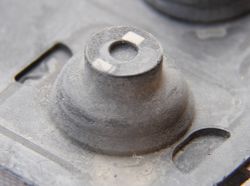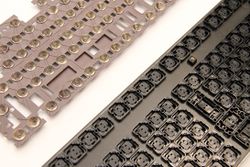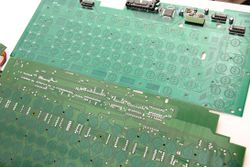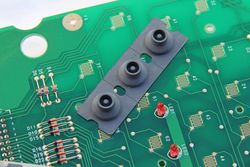Difference between revisions of "Topre switch"
m (Added TODO photo) |
(Added gallery images and Updated TODO Photo. Planning to keep capacitive and conductive in separate sub-galleries for now. Yes I know they share components.) |
||
| Line 1: | Line 1: | ||
| − | {{TODO photo|more=true|reason=need internals shots ( | + | {{TODO photo|more=true|reason=need more internals shots (Short-throw, silent, etc.)}} |
{{infobox dswitch | {{infobox dswitch | ||
| image name = Topre_Switch2.jpg | | image name = Topre_Switch2.jpg | ||
| Line 66: | Line 66: | ||
| [[File:Sony BKE 2011 - Switch Dome Close.JPG|200px]] || Alternate dome design used on a conductive Topre switch variant. The only known board to exist with these switches is the [[Sony BKE-2011]]. It is suspected that this design was also used on the Sony NWS-1200<ref>matsusaka.ne.jp - [http://matsusaka.ne.jp/~ueno/techical/WS/T-NWS-1200.html Details of a chattering issue repair attempt on a Sony NWS-1200] (website is in Japanese)</ref>, however, complete details of the NWS-1200 are not known. The slider design is the same as seen on the standard Topre capacitive switch. | | [[File:Sony BKE 2011 - Switch Dome Close.JPG|200px]] || Alternate dome design used on a conductive Topre switch variant. The only known board to exist with these switches is the [[Sony BKE-2011]]. It is suspected that this design was also used on the Sony NWS-1200<ref>matsusaka.ne.jp - [http://matsusaka.ne.jp/~ueno/techical/WS/T-NWS-1200.html Details of a chattering issue repair attempt on a Sony NWS-1200] (website is in Japanese)</ref>, however, complete details of the NWS-1200 are not known. The slider design is the same as seen on the standard Topre capacitive switch. | ||
|} | |} | ||
| + | |||
| + | ==Gallery== | ||
| + | ===Internal Components (Capacitive Switch)=== | ||
| + | <gallery widths=250 heights=187> | ||
| + | File:Topre Dome - Capacitive Style Dome.jpg|A rubber dome from the switch of a heavily used Topre keyboard. This design is used in all capacitive switch Topre keyboards. | ||
| + | File:Topre Dome Sheet and Mounting Plate.JPG|Underside of a rubber dome sheet (left) and the switch mounting plate from a Topre keyboard. The conic springs are still in their place on the dome sheet. | ||
| + | File:Topre Mounting Plate with Switches.JPG|Side view of the mounting plate (with PCB removed) showing two switches with keycaps still in place. | ||
| + | File:Topre PCBs (back) - FR-4 Glass Epoxy and FR-2 Paper Phenol.JPG|Underside view of two PCBs taken from separate keyboards. The green one at the top is a glass epoxy type, and the brown one is a paper phenol type, used in older keyboards. | ||
| + | File:Topre PCBs (front) - FR-2 Paper Phenol and FR-4 Glass Epoxy.JPG|Contact side view. Paper phenol on the left; glass epoxy on the right. | ||
| + | File:Topre PCBs (front) - FR-4 Glass Epoxy and FR-2 Paper Phenol.JPG|Contact side view. Glass epoxy at the top; paper phenol below. | ||
| + | File:Topre Switch Housings - Standard (left) and Hi-Pro (right).jpg|Switch housings from a Hi-Pro style keyboard (left) and a standard Topre switch. The sliders have been removed from both. | ||
| + | File:Topre Sliders - Hi-Pro (left) and Standard (right).jpg|Switch sliders from a Hi-Pro style keyboard (left) and a standard Topre switch. They appear to be the same height, however the base design is slightly different. | ||
| + | File:Topre Springs - Switching and Spacebar.jpg|Springs from a switch (left) and space bar. The switching spring plays an essential role in the switch actuation. Without it, a key-press will not register. | ||
| + | File:Topre Screws - Case, Ground, PCB type 1 and 2.jpg|Screws from a Topre keyboard. From left to right: Case screw for holding the keyboard case shut, Grounding screw, PCB screw (type 1) and PCB screw (type 2). | ||
| + | </gallery> | ||
| + | |||
| + | ===Internal Components (Conductive Switch)=== | ||
| + | <gallery widths=250 heights=187> | ||
| + | File:Sony BKE 2011 - Switch Dome Close.JPG|A rubber dome from the switch of a [[Sony BKE-2011]]. Conductive rubber contacts are used on this dome design, instead of the standard capacitive switching used in most Topre keyboards. No conic spring is required. | ||
| + | File:Sony BKE 2011 - Switch Dome Top.jpg|Top view of the rubber dome. | ||
| + | File:Sony BKE 2011 - Switch Dome Side.jpg|Side view of the rubber dome. | ||
| + | File:Sony BKE 2011 - Switch Dome Bottom.jpg|Bottom view of the rubber dome. Note the black carbon contact pad in the centre. | ||
| + | File:Sony BKE 2011 - Switch Dome Cluster.JPG|Cluster of switch domes from the top-right corner of the Sony BKE-2011 keyboard. | ||
| + | File:Sony BKE 2011 - Switch Domes Bottom.JPG|Bottom view of rubber domes. Note the individual domes along the middle are designed to allow the LEDs on the PCB to pass through. | ||
| + | File:Sony BKE 2011 - Membrane Bottom.JPG|PCB contact side of the membrane. The design is strange as it would seem that the membrane is carbon-coated, which would negate the need for carbon pads on the domes. | ||
| + | File:Sony BKE 2011 - Membrane Carbon Contact Pads.jpg|Closeup of the carbon-coated pads on the membrane. | ||
| + | File:Sony BKE 2011 - Membrane Top.jpg|Dome contact side of the membrane. | ||
| + | File:Sony BKE 2011 - PCB Top.JPG|PCB from a Sony BKE-2011, showing the contact traces, LEDs and diodes. | ||
| + | File:Sony BKE 2011 - PCB Top Right.JPG|Closeup of the contact traces on the PCB. | ||
| + | </gallery> | ||
== Availability == | == Availability == | ||
Revision as of 10:39, 24 September 2013
| This article requires additional photographic illustration — need more internals shots (Short-throw, silent, etc.) |
 | |
| Manufacturer | Topre Corporation |
|---|---|
| Switch type | Tactile |
| Actuation force | 30, 35, 45, and 55 cN |
Contents
History
Topre switches, are, as described by Topre Corp., the 'Only one "Made in Japan" electrostatic capacitive non-contact type keyboard in the world'.
From the Topre Patent:
"The present invention has been made in consideration of the above situation, and has as its object to provide a keyboard switch wherein constant hysteresis can be obtained without changing the operation characteristics even if an operation value is arbitrarily set, thereby properly preventing chattering, and wherein an operator can know that the operation member has been depressed to a depth corresponding to the operation value. According to one aspect of the present invention, there is provided a keyboard switch comprising an insulating substrate, a first electrode laid on the insulating substrate, a second electrode facing the first electrode, a dielectric disposed between the first and second electrodes, said second electrode being formed of a conical coil spring, and being positioned on the dielectric so that one end portion of the spring may be in contact with the surface of the dielectric, a capacitance between the first and second electrodes being mainly defined by the contact area between the dielectric and second electrode, a button on the other end portion of the second electrode for compressing the second electrode toward the first electrode to change the contact area when the button is depressed toward the first electrode, said capacitance varying with the change in the facing area which changes substantially in proportion to the depth of depression of the button, and a means for giving snap feeling to an operator when the button is depressed and the capacitance exceeds a given value, whereby the switch is capacitively coupled for a switching operation and the snap feeling is given to the operator when the capacitance exceeds the given value."
Construction
The switch consist of a slider in a housing over a rubber dome over a conical coiled spring over a printed circuit board. Switches are discrete components, but built as "sheets".
The rubber dome provides most of the resistance and tactile feel. Keyboards can have differently weighted rubber domes on different keys, similar to the Key Tronic ErgoForce.
When the conical spring is compressed, a capacitative sensing mechanism on the PCB senses the key press mid-actuation. Circuitry on the PCB collects sensing data from smaller key groups and feeds it to the controller. This scheme has the capacity for providing N-key roll-over.
All stabilizer bars are located inside the keyboard, often as part of each switch, connected to the slider itself. Most stabilized keys are mounted only in the centre; On many keyboards, only the space bar needs two extra stabilizing mounts on the sides.
Key feel
In essence, the Topre switch feels first like a refined rubber dome and second in some ways reminiscent of some mechanical-contact switches such as the Cherry MX Red and Cream Alps.
The switch action is very smooth, with a tactile bump that you can feel near the top of the stroke. After the bump, the resistance is almost flat, making it difficult to avoid bottoming out. You can not feel the mid-stroke actuation point. It bottoms out distinctly with a "thock" sound.
Some Topre keys are very light, which can lead to unintended key activations; this happens especially on keyboards that have differently weighted switches for different fingers.
Categorization
There is an ongoing disagreement within the keyboard community whether this switch should be categorized as "mechanical", as "rubber dome" or even as "semi-mechanical". Some of this controversy might be based on disagreement whether the categorization should be based on the switch's construction (there being a rubber dome inside it vs. there being a metal spring inside it -- the Topre switch having both) or by some of its properties (crisp, light feel and mid-stroke actuation point) being different from typical rubber-dome keyboards.
The switch's rubber dome does provide most of its resistance and all of the tactile feel, but unlike typical rubber dome keyboards, the rubber dome in the Topre switch does not provide any "mushy" resistance near the bottom of the stroke. The conical spring provides only around 5 cN of actuation force and is therefore a critical component only for sensing key presses.
Switch Variations
| Example Image | Description |
|---|---|
 |
The standard Topre switch. This is by far the most prevalent.
Available in many different weights and present on the vast majority of Topre made keyboards. |
 |
These purple switches are used in Realforce keyboards.
It is suspected that they are only used in the 'Low Noise' Realforce models, although this is unconfirmed. |
 |
This is the Topre Short-throw switch used in compact layout keyboards. It was previously thought to only exist in 55cN weighted configurations, however, this assumption was based on measurements gathered or guessed at by users. The only known cited force measurement for Topre Short-throw boards is '40±15%' which presumably means 40 grams with a 15% margin for error[1].
Examples of keyboards that employ these switches can be seen here |
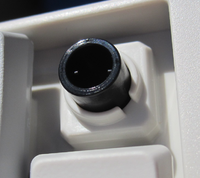 |
Two-tone switches used on the HHKB (Type-S pictured).
The main switch housing is moulded onto the plastic. Only the plunger can be removed, as opposed to the standard Realforce switch, which can be removed completely from the mounting plate. |
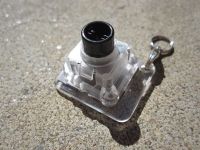 |
Second revision of the Topre keychain switch, provided at promotional Realforce events in Japan.
This version has a clear acrylic housing and a coloured keycap with ‘REALFORCE’ printed on the top. The ‘A’ symbol on the second revision is coloured red as per Topre’s standard advertising for Realforce keyboards. The first version had a clear acrylic base only. It also has a coloured keycap and the ‘REALFORCE’ print on the top, without the red ‘A’ symbol. |
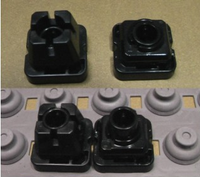 |
High set, or 'Hi-Pro' switches, pictured here to the left of a standard Topre switch.
These are used in a number of Topre keyboards including the Realforce branded 108UG, 104UG and 104UK Hi-Pro keyboards, as well as some Topre OEM data entry keyboards such as the Juki Celavi-i, Juki Datum, NISSHO KB106DE and the Hatsuko Electronics HEKB01. All keyboards have tall, spherical keycaps. |
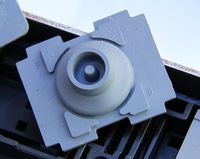 |
Alternate dome design used on a conductive Topre switch variant. The only known board to exist with these switches is the Sony BKE-2011. It is suspected that this design was also used on the Sony NWS-1200[2], however, complete details of the NWS-1200 are not known. The slider design is the same as seen on the standard Topre capacitive switch. |
Gallery
Internal Components (Capacitive Switch)
Internal Components (Conductive Switch)
A rubber dome from the switch of a Sony BKE-2011. Conductive rubber contacts are used on this dome design, instead of the standard capacitive switching used in most Topre keyboards. No conic spring is required.
Availability
See also
References
- ↑ web.archive.org - CTC SP catalogue dated February 2003 with Topre Short-throw model information
- ↑ matsusaka.ne.jp - Details of a chattering issue repair attempt on a Sony NWS-1200 (website is in Japanese)

